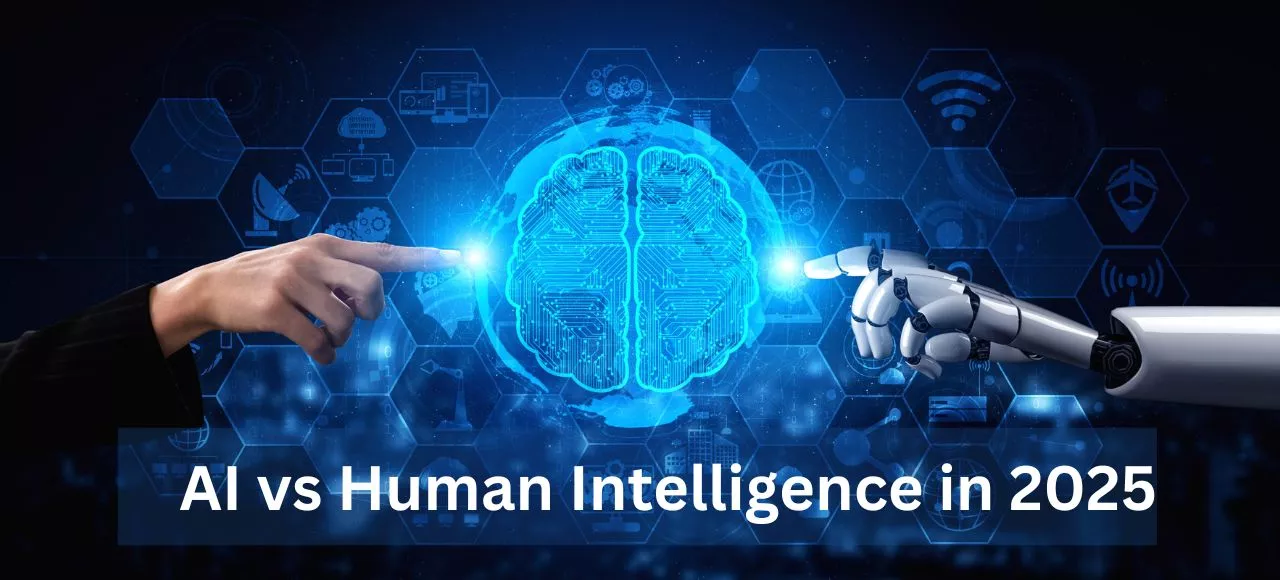The year 2025 brings us to a significant stage in the discussion between artificial intelligence (AI) and human intelligence. With rapid developments in AI, the line between machine-based problem-solving and human thinking is becoming less clear. While AI can now perform many tasks that were once done by humans, there are still areas where human intelligence shines.
This blog will compare the strengths and weaknesses of AI and human intelligence in 2025, supported by data, tables, and graphs to offer a clear picture.
Table of Contents
- Introduction
- What is AI and Human Intelligence?
- Comparing AI and Human Intelligence
- Cognitive Abilities
- Learning and Adaptation
- Creativity and Innovation
- Areas Where AI Excels Over Humans
- Human Abilities AI Cannot Copy
- The Future of AI and Human Collaboration
- Conclusion
1. Introduction
As AI becomes more advanced by 2025, its use has spread across many fields, like healthcare, banking, education, and more. AI systems are good at tasks like finding patterns, processing data, and even predicting outcomes. But humans still hold the advantage in areas like creativity, emotions, and making ethical decisions. The real challenge for the future is to use both AI and human intelligence together in a way that brings out the best of both.
2. What is AI and Human Intelligence?
Artificial Intelligence (AI): AI refers to machines or systems that try to copy human thinking. These systems can learn, solve problems, and understand language using computer programs and data.
Human Intelligence: Human intelligence includes abilities like critical thinking, creativity, emotions, and learning from life experiences. Unlike AI, human intelligence is flexible, driven by feelings, and capable of making decisions based on values.
| Comparison | Artificial Intelligence | Human Intelligence |
|---|---|---|
| Learning | Learns from data | Learns from experiences and logic |
| Creativity | Creates based on patterns | Unique, abstract creativity |
| Problem Solving | Follows specific rules | Complex and intuitive |
| Emotional Intelligence | No emotional understanding | High emotional awareness |
| Ethics & Morality | Based on pre-programmed rules | Decides based on values and feelings |
3. Comparing AI and Human Intelligence
3.1 Cognitive Abilities
AI’s strength is in processing large amounts of information very quickly. For example, AI can analyze millions of data points and find patterns faster than humans. But humans have the ability to think creatively and solve problems in ways that AI cannot. Humans also bring ethics and empathy into decision-making, which AI cannot do.
3.2 Learning and Adaptation
AI improves by being fed more data and learning through algorithms, but it has limits. Humans, on the other hand, learn from various life experiences and can adjust to new and unfamiliar situations. AI depends heavily on the data given to it, while humans use feelings, creativity, and intuition.
| Factor | AI | Human Intelligence |
|---|---|---|
| Learning Speed | Fast with large datasets | Slower but adaptable |
| Adaptation | Limited to trained data | Highly adaptable to new problems |
| Memory Retention | Unlimited digital storage | Limited but context-aware memory |
4. Areas Where AI Excels Over Humans
There are several industries where AI performs better than humans because of its speed, accuracy, and efficiency.
- Healthcare: AI can scan medical images, detect diseases, and analyze data more accurately and faster than human doctors.
- Finance: AI can perform real-time stock analysis and make faster trading decisions compared to human traders.
- Manufacturing: AI-controlled machines work without breaks, ensuring high precision and productivity without errors.
| Industry | AI Strength | Human Limitation |
|---|---|---|
| Healthcare | Fast and precise diagnosis | Slower interpretation |
| Finance | Quick and accurate predictions | Takes longer to react |
| Manufacturing | 24/7 operation without fatigue | Prone to errors and fatigue |
5. Human Abilities AI Cannot Copy
While AI is excellent at specific tasks, there are some key areas where humans still have the upper hand.
- Creativity and Innovation: Humans have the ability to think in completely new ways and come up with ideas that have never existed before. AI can only create based on patterns it has seen before.
- Emotional Intelligence: Humans can understand emotions, show empathy, and respond to others in a way that AI simply cannot. This is important in jobs like teaching, counseling, and leadership.
- Moral and Ethical Judgment: AI follows programmed rules and cannot make moral decisions on its own. Humans use values, emotions, and social understanding to make difficult decisions.
6. The Future of AI and Human Collaboration
In 2025, the best outcomes will likely come from AI and humans working together rather than competing. AI can take care of repetitive, data-driven tasks, allowing humans to focus on areas where emotional intelligence, creativity, and ethical decisions are needed.
- AI is great for handling data, automating tasks, and solving problems quickly.
- Humans bring creativity, empathy, and the ability to think deeply about complex problems.
Graph: Growth in AI Adoption by Industry (2018–2025)
The graph below shows the percentage increase in AI use across key industries from 2018 to 2025.
| Year | Healthcare | Finance | Manufacturing |
|---|---|---|---|
| 2018 | 15% | 25% | 30% |
| 2020 | 30% | 45% | 50% |
| 2023 | 50% | 65% | 70% |
| 2025 | 70% | 80% | 90% |
7. Conclusion
In 2025, AI and human intelligence are not enemies but partners. AI is excellent at processing data, automating tasks, and solving problems faster than humans. But humans remain superior in areas like creativity, emotional intelligence, and making ethical choices. The future workforce will likely be a combination of AI and human skills, where machines and humans work together to achieve things that neither could do alone. The focus should not be on replacing humans but on using AI to enhance human abilities and make our lives easier.










